
Worldcarblog.com
Mercedes presented the redesigned A class PHOTO/VIDEO
As expected, the visual changes compared to the current model are minimal.
Halfway through its life cycle, Mercedes refreshed the entire A-Class range, including the sedan version. Cosmetic changes are minor and include slightly revised headlights with optional LED lights along with a redesigned radiator grille with a texture made up of miniature three-pointed stars.
At the rear, the German premium brand has installed a new diffuser and standard LED stop lights. Four new wheel design options have also been added, and the dimensions of the alloy wheels go up to a maximum of 19 inches.
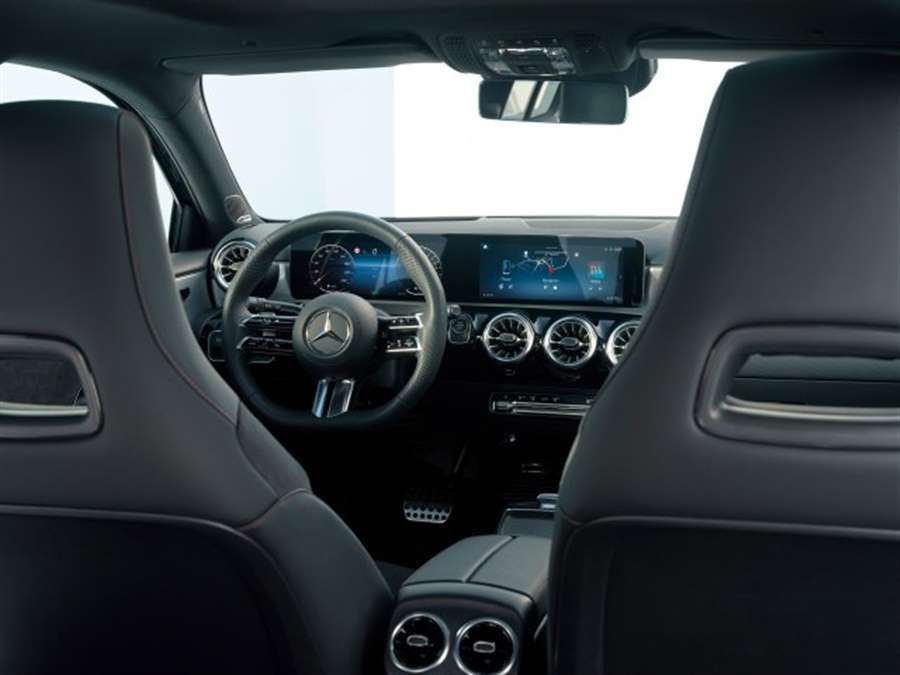
In the passenger cabin, the updated steering wheel is wrapped in Nappa leather as standard, while the center console has received some minor revisions.
The latest MBUX multimedia system continues to use two digital screens as standard. The smaller, 7-inch one is placed in front of the driver and serves as an instrument panel, while the right one, sensitive to touch, has a diagonal of 10.25 inches.
In addition, a configuration with two 10.25-inch displays is available as an option.
{vembed Y=MFXtZgW5w70}
As for the engine, the petrols have received the "mild" hybrid treatment and are paired with a seven-speed or eight-speed dual-clutch automatic transmission as standard.
Electric 48-volt technology provides an additional 13 horsepower (10 kW) of power.
In the plug-in hybrid version, the electric motor now delivers an additional 7 hp (5 kW), so the total electric power is now 109 hp (80 kW).

Owners can charge the battery with alternating current on a charger of up to 11 kW or direct current up to 22 kW. In the case of the latter, it takes 25 minutes to charge the battery from 10 to 80 percent capacity.
Mercedes also presented the AMG A35 versions in hatchback and sedan formats, while the A45 S remains available only as a 5-door model.
The weaker of the two performance models gets stylish ones that visually bring it closer to the top range. In addition, the AMG A35 gets a "light" hybrid system and switches to an eight-speed DCT, instead of the previously used seven-speed automatic.
Power remains unchanged, 306 hp (225 kW), with 400 Nm of torque.
The Mercedes-AMG A45 S gets a Street Style edition with an assortment of visual enhancements. The Limited Edition is painted in Mountain Gray Magno and features an aero kit as well as new 19-inch matte black wheels with red brake calipers.
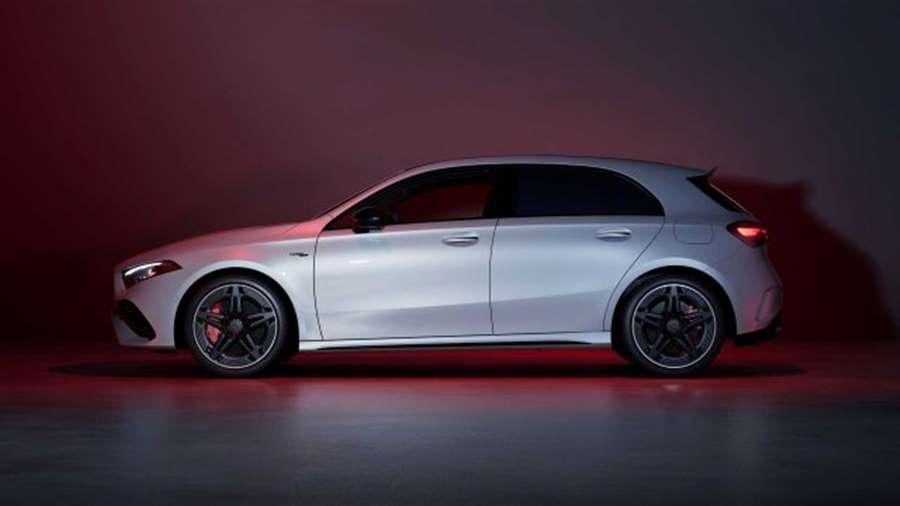
You'll also notice retro decals on the body, along with bright orange accents inside, along with aluminum trim.
The Mercedes A 45 S still has 422 hp (310 kW) and 500 Nm, but it is no longer the most powerful four-cylinder engine installed in a production car.
Placed longitudinally in the new AMG C63, the same M139 generates an incredible 476 hp (350 kW) and 545 Nm. The smaller version of the four-cylinder still allows the AMG A45 S to reach 100 km/h in 3.9 seconds and a top speed of 270 km/h.
It will be interesting to see if there are any plans to put a more powerful engine in the compact car, but one should not hope too much for that.
The return of the legend: the new Renault 4 debuts in Paris
The modern version of the famous car will premiere on October 17.
Thirty years after the end of production of the original "four", the French manufacturer will present its new take on the Renault 4 at the 2022 Paris Motor Show.
A team of designers working under the baton of Gilles Vidal, Renault's vice president of design, created a modern version of the cult model that left its mark on the automotive industry of the second half of the 20th century.
Based on the first "teasers", it can be concluded that the new "four" will be a crossover vehicle, and it is expected to have an electric drive.
As a reminder, the original Renault 4 was produced from 1961 to 1993, and during that time a total of over 8 million of these vehicles were sold.
The successor will certainly have a retro design, with elements of futuristic style, while everything else, including the price, will be a new story.
New Renault Megane E-Tech 2022 review
The Renault Megane returns as an all-electric SUV, and is all the better for it
Verdict
Renault has moved with the times with the new Megane, and the switch to full-electric power makes it one of the most convincing models to wear the badge since its debut 27 years ago. It’s spacious, accomplished to drive and has the best in-car tech in its class. There are some minor flaws – improved efficiency would be welcome – but it has fewer than most rivals. If you’re looking for a family EV, the Megane must be on your shortlist.
The Renault Megane is one of those cars that have become part of the establishment within the automotive landscape. The name is among the most recognisable in the family car class, having been on our roads since 1995; only the Volkswagen Golf, Honda Civic, Toyota Corolla and Vauxhall Astra are longer-serving badges in this segment.

It’s a big deal, then, when a new Megane comes out. It’s an even bigger deal when the car that Renault releases represents such a radical departure from what went before it. And despite what you might think when you see the dramatic new crossover’s proportions, we’re not talking about the design. That’s because the most significant change here is that the fifth-generation Megane is all-electric.
Under the skin, it uses the CMF-EV platform, which is the same tech as our Car of The Year, the Nissan Ariya. However, the Megane uses a different motor, made in France by Renault, which in UK-spec models produces a healthy 217bhp. There are no rare earth metals in the motor, and when that’s combined with the 20kg of recycled material that’s used in every Megane – including plastic bottles for the seat upholstery – the car’s sustainability credentials are boosted.

Energy is supplied by a super-slim 60kWh battery, which results in a cabin space that’s similar to a Volkswagen ID.3’s. That means it’s acceptable, but still a little tight in the rear. At 440 litres, the deep boot is generous, although there is a load lip.
The interior feels miles ahead of the VW’s, though. Quality is a step up on its rival, but it’s the ergonomics that really set it apart. The Megane has proper physical controls for the climate functions, for a start.
One of the areas that Renault is most proud of is the Android Automotive-based infotainment system. It claims that the screen sharpness is class-leading, and that the system is as responsive to use as a smartphone. It’s a fair claim – touch response and loading times are excellent, while “Okay Google” voice commands can be used not only for route guidance, but also to adjust the drive modes and ambient lighting. This is one of the very best in-car systems on the market, and Renault says that there’s more to come, too; future over-the-air updates will bring further improvements and additional functionality.
The Megane is also impressive on the road. Refinement is its strongest point, with wind and road noise plus suspension knocks well isolated from the cabin. The Megane’s driving dynamics are above average for the class, but despite quick steering and a kerbweight that undercuts most rivals, it’s still a 1,636kg hatchback.

The car’s weakness is its low-speed ride. The chassis never quite settles over uneven surfaces, causing a constant fidget. It’s never harsh, though, and larger bumps are rounded off nicely. Performance is strong, too, with 0-62mph taking 7.5 seconds. Normal mode is best; in Sport the throttle response feels a little too sharp.
There are four levels of brake regeneration to choose from, which can be easily adjusted via steering wheel paddles. When energy recovery is operating, it automatically depresses the brake pedal. This is supposed to be clever, but in reality it feels odd.
A mix of twisty B-roads, motorways and some town driving resulted in efficiency of 3.7 miles per kWh on our test drive, and an estimated real-world range of around 230 miles, well short of the official 280-mile claim. However, if you mainly do urban driving, you can expect much better.
Renault is keeping the Megane line-up simple, with a single powertrain and three trim levels. Beyond the colour, there are no optional extras to add to any of them.
The range kicks off with the £35,995 Equilibre, which gets a 12.3-inch driver display, rear parking sensors and camera, a heated steering wheel, adaptive cruise, traffic sign recognition and USB-C ports. However, it misses out on the Google-based infotainment, which is standard on £38,495 Techno models. This trim also adds front parking sensors, wireless phone charging, blind-spot warning and active lane centring.
Launch Edition is the current range- topper and gets 20-inch wheels and a gold front bumper insert. Inside, there’s a digital rear-view mirror, a nine-speaker Harman Kardon audio system and a surround-view parking camera. At £39,995, it’s much less than a top-spec Cupra Born.
The main challenger for the Megane will be the MG4. It feels cheaper than the Megane in several areas, but costs less, so it’s easy to forgive these shortcomings – ironically something often noted about Renault’s budget brand, Dacia.
Source: autoexpress.co.uk
Shock discovery: The automatic braking system does not work when it is most needed
Most new vehicles sold in Europe and America are equipped with automatic emergency braking (AEB) as standard. However, new tests of the capabilities of this safety system have shown that it fails when it is most needed - at higher speeds.
Technology that uses radar, cameras or LiDAR to spot potentially dangerous situations has proven to be great at reducing the chance of rear-end collisions at lower speeds. However, problems arise at higher speeds, head-on collisions and at T intersections.
The American Automobile Association (AAA) tested the automatic emergency braking system in four vehicles (Ford, Honda, Chevrolet and Toyota) at higher speeds. AAA tested the systems in two scenarios at T intersections, with vehicles going straight through the intersection encountering an oncoming vehicle, and a vehicle turning left entering the path of an oncoming vehicle.
These are actually the deadliest types of traffic accidents in America, accounting for 39.2 percent of all deaths in two-vehicle crashes, and the emergency braking system test results were very modest.
At a speed of 46 km/h, AEB prevented a rear-end collision in 17 out of 20 test drives, i.e. in 85% of cases. For the test drives where the crash occurred, the vehicle's speed was reduced by 86%. On the other hand, at 62 km/h, this system prevented an accident in only 6 out of 20 test drives, or about 30% of cases. For the crash test runs, the speed was reduced by 62%.
However, the biggest debacle of this system occurred in tests at T intersections, where collisions occurred 100% of the time. The automatic emergency braking system did not manage to warn the driver, slow down the vehicle's speed or avoid a collision.
As the HAK Review writes, because of these results, AAA recommends that car manufacturers focus on creating systems that will perform better in crashes where injuries and deaths are most likely. In addition, drivers should be aware of the limitations of their vehicles, i.e. they should know that despite all safety systems, they must be maximally focused on traffic and react in time.
New car buyers trust Toyota
J.D. Power's 2022 Car Brand Loyalty Study has just been released, and among new car buyers, one brand stands out as a favorite.
Actually, there are four of them, but only one dominates the two categories of this established research. That brand is Toyota, although Ford recorded the highest percentage of loyal customers by a slight margin compared to the Japanese brand.
This study is now in its fourth year, and involves exclusively surveying new car buyers. In addition, it is focused on those people who practice shopping "old for new", staying true to the brand. Therefore, the survey includes only authorized sellers, using data from J.D. Power's news networks. There is good demand for used cars at the moment, but this study provides an interesting insight into the loyalty of customers who are patient enough to wait for the delivery of their new tin pet, given that stocks are reduced.
Toyota has quite a loyal following. The Japanese manufacturer is ranked in the leading position in the category of mass-produced cars and SUVs/crossovers, achieving a loyalty rate of 62.2 percent for passenger vehicles and 63.6 percent when it comes to SUVs/crossovers.
Of course, premium brands are also ranked, and among them are the leading Porsche with 57.4 percent, i.e. BMW, which reigns in the SUV/crossover class with 58.6 percent. Pickup trucks are the final category in the survey and it is naturally dominated by Ford, whose loyalty rate is 63.8 percent, which is slightly better than Toyota in terms of the best result.
"There are many ways to cultivate customer loyalty, but each winning brand demonstrated a commitment to fresh product launches, great processes focused on vehicle owners, great residual value and an attractive offering," said VP J.D. Data and Analytics Power, Tyson Jomini. "And they're the ones who are winning the most in terms of market share."
In the premium segment, Genesis in the car category (54.6 percent) and Lexus in the SUV/crossover class (56.4 percent) also rank well. Second place among mass-produced manufacturers went to Kia (54.1 percent) and Subaru for SUVs/crossovers (62.6 percent). Toyota almost didn't get the third title, finishing behind Ford in the pick-up truck category with 58.7 percent.
2023 BMW M4 CSL Is Not for the Faint of Heart
This ultimate M car is BMW's answer to the Porsche 911 GT3 and the upcoming Mercedes-AMG C63 S E-Performance.
At an indicated 274 km/h (170 mph) on the Autobahn A94 Munich-Passau in the 2023 BMW M4 CSL, we muster the last crumbs of courage and stretch out the right foot all the way. Guess what happens? The thing downshifts into seventh. At a ludicrous 5800 rpm, a token 1400 rpm below the redline—ignoring the danger to the driver's ancient heart. At 300 km/h sharp (186 mph), it upshifts into eighth again, still accelerating, but now with the digital speed readout increasing by 1 km/h at a time. (It’s 5:30 a.m., and there's no traffic in sight, so the relative risk is at its lowest.) Theoretically, this ultimate M car is capped at 191 mph. But what looked at first like a barely noticeable kink up ahead in the freeway suddenly felt like A Very Serious Corner. "Never lift"? T-shirts rarely tell the true story, but the rearview mirror always does. And it showed the driver grinning from ear to ear.
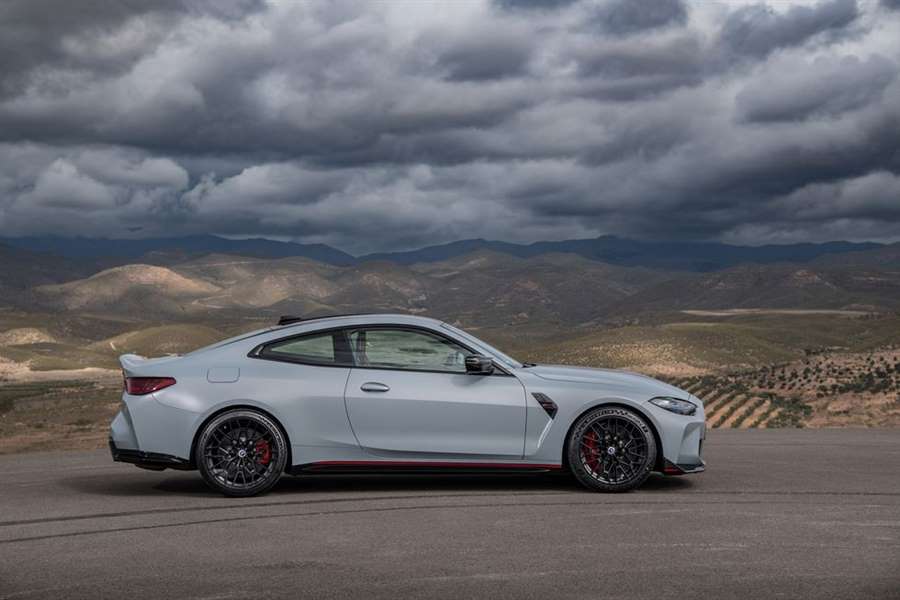
The M4 CSL is BMW's answer to the Porsche 911 GT3 and the upcoming Mercedes-AMG C63 S E-Performance. Like the hardest-core 911s, this BMW is strictly rear-wheel drive, and it shows, especially in the wet with Michelin Cup 2 R tires, which should only be legal in sunshine states, not in Bavaria. Compared to this beast, every other M4 is a kitten. For a start, the CSL is a claimed 190 pounds lighter than the base model. You can feel the weight savings, and you can also hear it. Stripped of its back seat, the rear compartment has mutated into a giant boom box. Some 24 pounds of removed sound-deadening material exacerbate the acoustic assault, with the carbon-fiber roof capping the resonance chamber, and the titanium exhaust designed to raise goosebumps. A whopping 53 pounds were saved by replacing the standard seats with carbon-fiber screw-clamps billed as sports buckets. Upping the pain coefficient of the seats is the lowered and stiffened suspension.
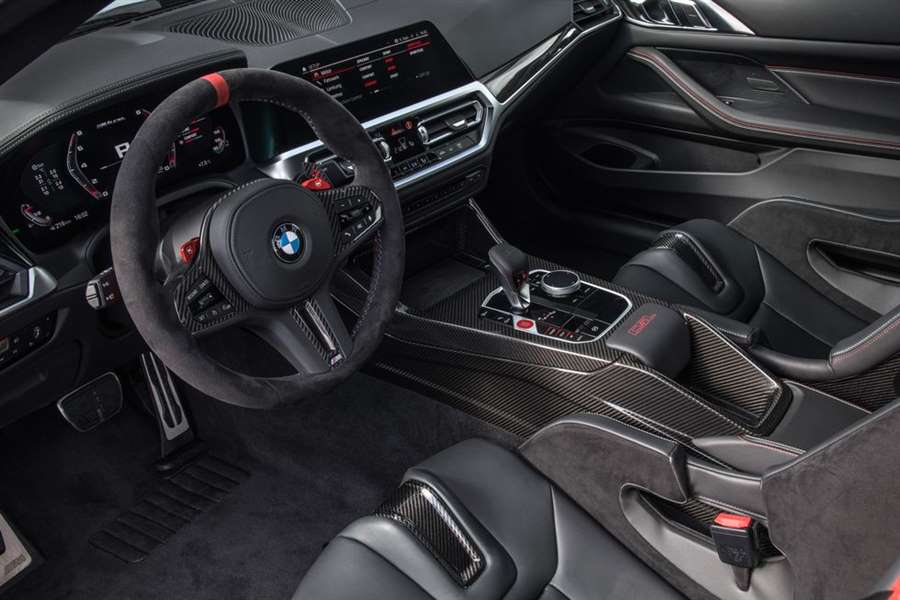
The first 20 miles are an I-hate-this-car experience. The 275/35ZR-19 and 285/30ZR-20 tires wriggle along like a quartet of eels. The dampers in Sport Plus are devoted wholly to shock, not absorption. The steering is initially too light to be trusted. And every blip of the throttle strikes your nervous system like lightning. You never relax in the M4 CSL, but the initial angst eventually does recede as curiosity replaces it, followed by the first bouts of let's call it confidence. In Sport, with tire temperatures at last where they should be, we finally dare to dive into the car's deep talent pool and snorkel for all the revelations it harbors. Like more cornering grip than a gallon of Loctite and more poise than such a zero-tolerance setup should be allowed to muster.
The CSL engine is the ultimate variation of the M division’s 3.0-liter twin-turbo straight-six. Its output is boosted from the base model's 473 horsepower and 406 pound-feet to 543 horsepower and 479 pound-feet. That's the good news. The bad news is the money thing. At a starting price of $140,895, one could buy two base M4s for the cost of a CSL with a few options. And BMW has closed the order books even before the first of the 1000 limited-edition models was delivered to a customer. Scarcity alone should make the striped-and-winged lightweight special an instant blue-chip investment—but is it? Although the CSL is exceptionally involving and outright faster than its siblings by some margin, our estimated zero-to-60 time of 3.3 seconds is eclipsed by the comparatively inconspicuous M4 Competition xDrive, which may be down 40 horsepower but has the same torque and hits 60 in 2.8 seconds, all for about $60K less.
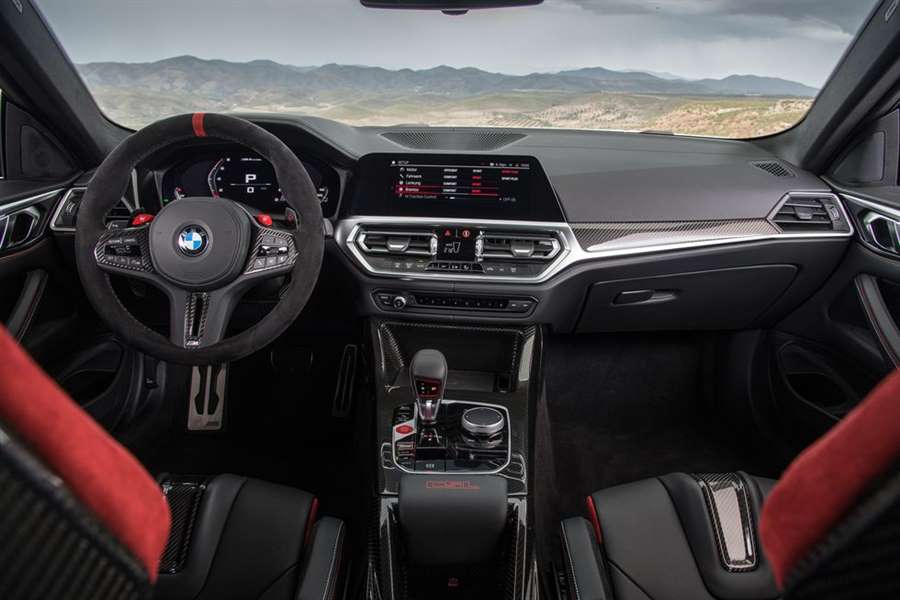
After just over 200 miles, we had to pit for fuel. The mileage? An OPEC-friendly 12 mpg. But what the hell? It finally stopped raining, and the winding route back to Munich promised a familiar Garden of Eden dotted with twisties and free of radar traps. Time to forget the tame preset M1 program and dial in the devil's own M2 composition instead. The preferred algorithm looked like this: engine in Sport Plus, gearbox in the S3 quick-shift setting, chassis in Comfort (compliance is control), DSC in MDM (M Dynamic Mode), steering and brakes in Sport.
Despite certain NVH conspicuities, the CSL drivetrain epitomizes absolute seamlessness. Hard acceleration brutality beams you through time and space, accompanied by a howling, growling, barely filtered soundtrack. The initially explosive, then increasingly progressive forward thrust has its antidote in the simply stupefying carbon-ceramic brakes. There's no doubt about it: This car makes your eyes pop out in one take only to flatten the earlobes in the next. It quite simply redefines the Ultimate Driving Machine.
Source: caranddriver.com
An even more powerful BMW XM with 748 HP is coming
BMW has released the first photo of the exclusive Label Red version of the new XM model.
Label Red will make the XM the most powerful hybrid crossover on the market. As the nameplate says, the car will be recognizable by its matte black paint and plenty of red accents that aren't available on the standard BMW XM variant.
BMW has also equipped the XM Label Red with distinctive wheels that combine gloss black spokes with bright red accents.
A photo of the interior is not yet available, but the German manufacturer says that the red and black color combination extends to the interior, along with specific decorative details.
Although BMW has not released all the technical details of the Label Red version, it has been confirmed that the drive system will be improved compared to the regular model, which has 653 hp (480 kW) and 800 Nm.
Thus, this exclusive will have a hybrid drive that produces as much as 748 HP (550 kW) and 997 Nm of maximum torque. Accordingly, better performance compared to the standard version and its 0-100 km/h acceleration of 4.3 s are expected.
The BMW XM Label Red will premiere in 2023, when we will have more information about this car.

















